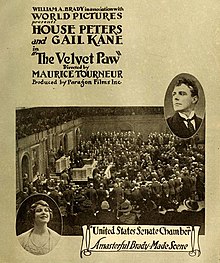Maurice Tourneur
This article needs additional citations for verification. (August 2023) |
Maurice Tourneur | |
|---|---|
 Tourneur in 1916 | |
| Born | Maurice Félix Thomas 2 February 1876 Épinettes, Paris, France |
| Died | 4 August 1961 (aged 85) Paris, France |
| Resting place | Père Lachaise Cemetery |
| Spouse(s) |
Fernande Petit
(m. 1904, divorced)Louise Lagrange |
| Children | Jacques Tourneur |
Maurice Félix Thomas (French pronunciation: [mɔʁis feliks tɔmɑ]; 2 February 1876 – 4 August 1961), known as Maurice Tourneur (pronounced [tuʁnœʁ]), was a French film director and screenwriter.[1]
Life
Born Maurice Félix Thomas in the Épinettes district (17th arrondissement of Paris), his father was a wholesaler. As a young man, Maurice Thomas first trained as a graphic designer and a magazine illustrator but was soon drawn to the theater. In 1904, he married the actress Fernande Petit. They had a son, Jacques (1904–1977), who would follow his father into the film industry, establishing his own reputation as a director of American films in the 1940s and 1950s.[2]
Using the

In 1914, with the expansion of the giant French film companies into the United States market, Tourneur moved to
“Making pictures is a commercial business, the same as making soap and, to be successful, one must make a commodity that will sell. We have a choice between making bad, silly, childish and useless pictures, which make a lot of money, and make everybody rich, or nice stories, which nobody wants to see...the American film producers will have to change entirely their machine-made stories and come to a closer and truer view of humanity...” - Maurice Tourneur in Shadowland, May 1920.[3]
Tourneur admired


After directing several innovative films for
After his trouble with MGM, Tourneur decided to move back to his native France. There, he continued to make films both at home and in Germany, easily making the change to
After his death in 1961, Maurice Tourneur was interred in the Père Lachaise Cemetery in Paris.
Maurice Tourneur was honored with a star on the Hollywood Walk of Fame at 6243 Hollywood Blvd.
His 1917 film,
Partial filmography
- Jean la Poudre (1912)
- The System of Doctor Goudron aka The Lunatics (1912)
- The Mystery of the Yellow Room (1913)
- Figures de cire (1914)
- Mother (1914) Extant
- The Man of the Hour (1914) Extant
- The Wishing Ring(1914) Extant
- Alias Jimmy Valentine (1915) Extant
- The Cub(1915) Extant
- The Ivory Snuff Box (1915) Lost
- The Butterfly on the Wheel (1915)
- The Pawn of Fate (1915)
- The Hand of Peril (1916)
- The Closed Road (1916)
- The Velvet Paw (1916) Lost
- The Rail Rider (1916) Extant(fragments)
- A Girl's Folly (1916) Extant
- The Whip (1917) Extant
- The Undying Flame (1917) Lost
- Exile (1917)
- The Law of the Land(1917) Lost
- The Pride of the Clan (1917) Extant
- The Poor Little Rich Girl (1917) Extant
- Barbary Sheep(1917) Lost
- The Rise of Jennie Cushing (1917) Lost
- Rose of the World (1917) Lost
- The Blue Bird (1918) Extant
- Prunella(1918) Lost
- A Doll's House (1918) Lost
- The Sporting Life(1918) Lost
- Woman (1918) Lost
- My Lady's Garter (1919) Lost
- The White Heather (1919) Extant
- The Life Line (1919) Extant
- Victory (1919) Extant
- The Broken Butterfly (1919) Extant
- The County Fair (1920) Extant
- The Great Redeemer (1920) Lost
- While Paris Sleeps (1923) Lost
- Treasure Island (1920) Lost
- The White Circle (1920) Lost
- Deep Waters (1920) Lost
- The Last of the Mohicans (1920) Extant
- The Bait (1921) Lost
- Foolish Matrons(1921) Extant
- Lorna Doone (1922) Extant
- The Brass Bottle (1923) Lost
- Les Deux Gosses (1923)
- The Christian (1923) Extant
- The Isle of Lost Ships (1923) Lost
- Torment (1924) Lost
- The White Moth(1924) Extant
- The Sporting Life(1925) Extant
- Never the Twain Shall Meet (1925) Lost
- Aloma of the South Seas (1926) Lost
- Old Loves and New (1926) Lost
- The Crew (1928)
- The Ship of Lost Souls (1929)
- Accusée, levez-vous!(Accused, Stand Up!) (1930)
- Departure (1931)
- Dance Hall (1931)
- In the Name of the Law (1932)
- Les Gaietés de l'escadron(1932)
- The Two Orphans (1933)
- Le Voleur (1933)
- Justin de Marseille (1934)
- Koenigsmark (1935)
- Samson (1936)
- The Patriot (1938)
- Katia (1938)
- Sins of Youth (1941)
- Volpone (1941)
- La Main du diable (The Hand of the Devil, aka Carnival of Sinners) (1943)
- Cécile est morte(1944)
- After Love (1948)
- Dilemma of Two Angels (1948)
Footnotes
- ISBN 9780786409570
- ISBN 9780801865619
- ^ Koszarski, 1976 p. 76, p. 79 composite quote.
- ^ [1] IMDb listing
References
- Koszarski, Richard. 1976. Hollywood Directors: 1914-1940. Oxford University Press. Library of Congress Catalog Number: 76-9262.
External links
 Media related to Maurice Tourneur at Wikimedia Commons
Media related to Maurice Tourneur at Wikimedia Commons Works by or about Maurice Tourneur at Wikisource
Works by or about Maurice Tourneur at Wikisource- Maurice Tourneur at IMDb
- Some contemporary interviews with, and articles by, Maurice Tourneur
- Maurice Tourneur (kinotv)
